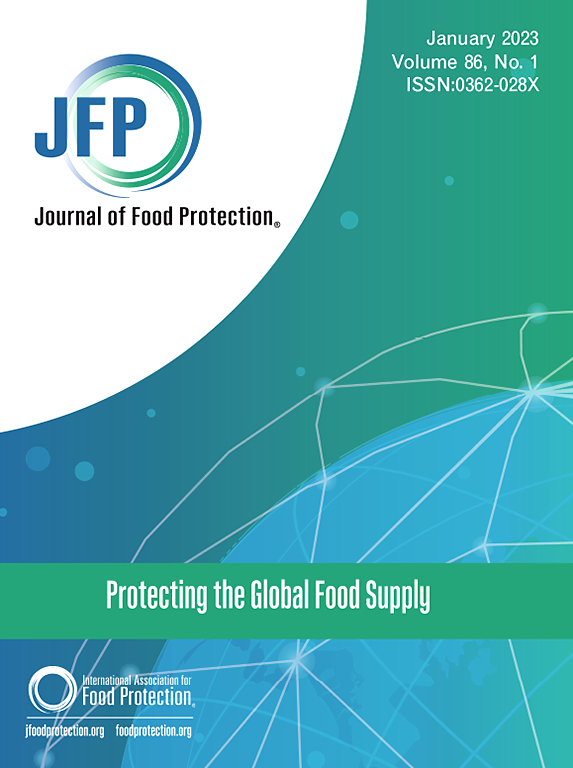改进卫生标准操作程序对三种果树包装设施微生物种群的影响。
IF 2.1
4区 农林科学
Q3 BIOTECHNOLOGY & APPLIED MICROBIOLOGY
引用次数: 0
摘要
清洁和消毒对控制食品加工设施中的李斯特菌至关重要。在此,我们评估了四种清洁卫生标准操作程序(SSOPs;T1、T2、T3、T4)在两个包装季节(Y1、Y2)中对三个树果包装设施(F1、F2、F3)中需氧嗜中性微生物总数的减少、单核细胞增多性李斯特氏菌的发生以及微生物群组成的影响。在施用 SSOPs 之前和之后,从非食品接触表面收集环境样本。采用标准平板计数法对需氧细菌总数进行定量,采用最可能数量法对李斯特菌属和单核细胞增多性李斯特菌的浓度进行定量。扩增子测序法用于确定细菌和真菌微生物群的组成,纳米孔测序法用于检测微生物群中可能促进单核细胞增多症在研究环境中存活和持续存在的功能元素。使用 SSOPs 可使细菌总数减少 0.27 至 2.48 log10 CFU/块(p ≤ 0.001)。在测试的处理方法中,在 T4 中加入生物膜去除剂最有效,可显著降低李斯特菌属的总浓度 1.57 至 1.27 log10 MPN/拭抹盘(p < 0.02)和单核细胞增生李斯特菌的频率,尽管后者在统计学上并不显著。我们观察到细菌和真菌微生物群组成在使用清洁和消毒 SSOP 后发生了不一致的变化,这可能是由于处理后存在死亡 DNA 的缘故。利用纳米孔测序技术,我们在所研究环境的微生物群中检测到了与生物膜形成和抗压力有关的功能元素。总之,我们的研究表明,SSOP 的实施改善了果树包装设施的卫生状况。今后的工作需要重点优化和验证标准操作程序,特别是在 SSOP 效果较差的区域,如蜡残留物覆盖的区域。本文章由计算机程序翻译,如有差异,请以英文原文为准。
Impact of Improved Sanitation Standard Operating Procedures on Microbial Populations at Three Tree Fruit Packing Facilities
Cleaning and sanitizing are of vital importance to control Listeria monocytogenes in food processing facilities. Here, we evaluated the effect of four cleaning and sanitation standard operating procedures (SSOPs; T1, T2, T3, T4) on the reduction of total aerobic mesophilic microorganisms, the occurrence of L. monocytogenes, and the microbiota composition in three tree fruit packing facilities (F1, F2, and F3) over two packing seasons (Y1 and Y2). Environmental samples were collected from non-food contact surfaces before and after the application of SSOPs. Total aerobic bacteria were quantified using a standard plate count method, and Listeria spp. and L. monocytogenes concentration was quantified using a Most Probable Number method. Amplicon sequencing was used to determine bacterial and fungal microbiota composition, and Nanopore sequencing was used to detect functional elements in the microbiota that could promote the survival and persistence of L. monocytogenes in the studied environments. The use of SSOPs reduced the total bacterial load by 0.27–2.48 log10 CFU/swab (p ≤ 0.001). Among the treatments tested, the inclusion of a biofilm remover in T4 was most effective in significantly reducing the total Listeria spp. concentration by 1.57–1.27 log10 MPN/swab (p < 0.02) and the frequency of L. monocytogenes, although the latter was not statistically significant. We observed inconsistent changes in the bacterial and fungal microbiota composition due to the application of cleaning and sanitizing SSOPs, which may be due to the presence of dead DNA after the treatment. Using Nanopore sequencing, we detected functional elements related to biofilm formation and stress resistance in the microbiomes of the studied environments. Overall, our study shows that the implementation of SSOPs improved the sanitation outcomes in tree fruit packing facilities. There is a need for the future work to focus on optimizing and validating the standard operating procedures, especially in the areas in which SSOPs were less effective, such as those covered with wax residues.
求助全文
通过发布文献求助,成功后即可免费获取论文全文。
去求助
来源期刊

Journal of food protection
工程技术-生物工程与应用微生物
CiteScore
4.20
自引率
5.00%
发文量
296
审稿时长
2.5 months
期刊介绍:
The Journal of Food Protection® (JFP) is an international, monthly scientific journal in the English language published by the International Association for Food Protection (IAFP). JFP publishes research and review articles on all aspects of food protection and safety. Major emphases of JFP are placed on studies dealing with:
Tracking, detecting (including traditional, molecular, and real-time), inactivating, and controlling food-related hazards, including microorganisms (including antibiotic resistance), microbial (mycotoxins, seafood toxins) and non-microbial toxins (heavy metals, pesticides, veterinary drug residues, migrants from food packaging, and processing contaminants), allergens and pests (insects, rodents) in human food, pet food and animal feed throughout the food chain;
Microbiological food quality and traditional/novel methods to assay microbiological food quality;
Prevention of food-related hazards and food spoilage through food preservatives and thermal/non-thermal processes, including process validation;
Food fermentations and food-related probiotics;
Safe food handling practices during pre-harvest, harvest, post-harvest, distribution and consumption, including food safety education for retailers, foodservice, and consumers;
Risk assessments for food-related hazards;
Economic impact of food-related hazards, foodborne illness, food loss, food spoilage, and adulterated foods;
Food fraud, food authentication, food defense, and foodborne disease outbreak investigations.
 求助内容:
求助内容: 应助结果提醒方式:
应助结果提醒方式:


